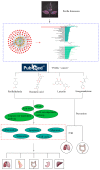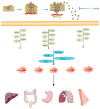The Role and Mechanism of Perilla frutescens in Cancer Treatment
- PMID: 37570851
- PMCID: PMC10421205
- DOI: 10.3390/molecules28155883
The Role and Mechanism of Perilla frutescens in Cancer Treatment
Abstract
Perilla frutescens is an annual herb of the Labiatae family and is widely grown in several countries in Asia. Perilla frutescens is a plant that is used medicinally in its entirety, as seen in its subdivision into perilla seeds, perilla stalks, and perilla leaves, which vary more markedly in their chemical composition. Several studies have shown that Perilla frutescens has a variety of pharmacological effects, including anti-inflammatory, antibacterial, detoxifying, antioxidant, and hepatoprotective. In the absence of a review of Perilla frutescens for the treatment of cancer. This review provides an overview of the chemical composition and molecular mechanisms of Perilla frutescens for cancer treatment. It was found that the main active components of Perilla frutescens producing cancer therapeutic effects were perilla aldehyde (PAH), rosmarinic acid (Ros A), lignan, and isoestrogen (IK). In addition to these, extracts of the leaves and fruits of Perilla frutescens are also included. Among these, perilla seed oil (PSO) has a preventive effect against colorectal cancer due to the presence of omega-3 polyunsaturated fatty acids. This review also provides new ideas and thoughts for scientific innovation and clinical applications related to Perilla frutescens.
Keywords: Perilla frutescens; active ingredient; mechanism; tumor.
Conflict of interest statement
The authors declare no conflict of interest.
Figures





Similar articles
-
Rosmarinic acid in Perilla frutescens and perilla herb analyzed by HPLC.J Nat Med. 2020 Mar;74(2):341-352. doi: 10.1007/s11418-019-01367-8. Epub 2019 Dec 17. J Nat Med. 2020. PMID: 31848798
-
Ethnomedicinal, Phytochemical and Pharmacological Investigations of Perilla frutescens (L.) Britt.Molecules. 2018 Dec 28;24(1):102. doi: 10.3390/molecules24010102. Molecules. 2018. PMID: 30597896 Free PMC article. Review.
-
[Comparison of active components in different parts of Perilla frutescens and its pharmacological effects].Zhongguo Zhong Yao Za Zhi. 2023 Dec;48(24):6551-6571. doi: 10.19540/j.cnki.cjcmm.20230813.201. Zhongguo Zhong Yao Za Zhi. 2023. PMID: 38212016 Chinese.
-
Molecular Mechanism of Antioxidant and Anti-Inflammatory Effects of Omega-3 Fatty Acids in Perilla Seed Oil and Rosmarinic Acid Rich Fraction Extracted from Perilla Seed Meal on TNF-α Induced A549 Lung Adenocarcinoma Cells.Molecules. 2021 Nov 9;26(22):6757. doi: 10.3390/molecules26226757. Molecules. 2021. PMID: 34833849 Free PMC article.
-
Phytochemical and phytopharmacological review of Perilla frutescens L. (Labiatae), a traditional edible-medicinal herb in China.Food Chem Toxicol. 2017 Oct;108(Pt B):375-391. doi: 10.1016/j.fct.2016.11.023. Epub 2016 Nov 24. Food Chem Toxicol. 2017. PMID: 27890564 Review.
Cited by
-
Ultrasound-assisted extraction, purification, sulfation of Perilla leaves polysaccharide and hypoglycemic and hypolipidemic activities.Ultrason Sonochem. 2025 Jun;117:107269. doi: 10.1016/j.ultsonch.2025.107269. Epub 2025 Feb 20. Ultrason Sonochem. 2025. PMID: 40258312 Free PMC article.
-
Recent trends in extraction, purification, structural characterization, and biological activities evaluation of Perilla frutescens (L.) Britton polysaccharide.Front Nutr. 2024 Feb 22;11:1359813. doi: 10.3389/fnut.2024.1359813. eCollection 2024. Front Nutr. 2024. PMID: 38585610 Free PMC article. Review.
-
Comprehensive Review of Perilla frutescens: Chemical Composition, Pharmacological Mechanisms, and Industrial Applications in Food and Health Products.Foods. 2025 Apr 3;14(7):1252. doi: 10.3390/foods14071252. Foods. 2025. PMID: 40238536 Free PMC article. Review.
-
Hawthorn with "homology of medicine and food": a review of anticancer effects and mechanisms.Front Pharmacol. 2024 Jun 10;15:1384189. doi: 10.3389/fphar.2024.1384189. eCollection 2024. Front Pharmacol. 2024. PMID: 38915462 Free PMC article. Review.
-
Assessing the Antioxidant Properties, In Vitro Cytotoxicity and Antitumoral Effects of Polyphenol-Rich Perilla leaves Extracts.Antioxidants (Basel). 2023 Dec 29;13(1):58. doi: 10.3390/antiox13010058. Antioxidants (Basel). 2023. PMID: 38247482 Free PMC article.
References
Publication types
MeSH terms
Substances
Grants and funding
LinkOut - more resources
Full Text Sources
Medical

